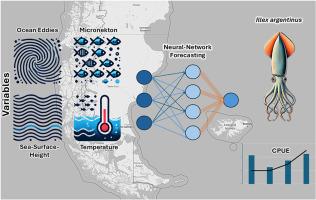基于海洋学特征的福克兰群岛阿根廷Illex argentinus时空丰度分析与预测
IF 2.6
3区 地球科学
Q1 MARINE & FRESHWATER BIOLOGY
引用次数: 0
摘要
Illex argentinus,俗称阿根廷短鳍鱿鱼,在巴塔哥尼亚陆架生态系统中具有重要的生态和经济意义。先前的研究发现,阿根廷巨蝮的时空分布与海洋学特征有关。本研究使用广泛的时间序列数据集、最先进的广义加性混合效应模型和新颖的LSTM神经网络(NN)方法来分析和预测阿根廷稻的时空丰度(以单位努力渔获量衡量)。此外,我们测试了环境变量和时间丰度之间的任何滞后,特别是采样前6个月。在采样时,较高的温度和微中子丰度对CPUE总体上有积极影响,而6个月前,它们对CPUE有负面影响。在较宽的FI区和福克兰海流内漩涡数量的增加对CPUE有积极影响,其他地区和6个月的延迟对CPUE有负面影响,漩涡密度增加。整体表现最好的模型是神经网络模型,该模型使用温度、浮游动物丰度和相关锋面进行每周CPUE预测,预测跨度为3周。除了证实了以往的研究结果,即阿根廷白鲟丰度依赖于温度和海锋,我们发现了更多相关的预测变量,如微藻丰度、海面高度和每面积涡旋数,这些都影响着阿根廷白鲟的时空丰度。我们发现,尽管巴塔哥尼亚大陆架的海洋过程很复杂,加上阿根廷巨虾的复杂迁移模式,神经网络仍然能够预测时间丰度。本文章由计算机程序翻译,如有差异,请以英文原文为准。

Analysing and forecasting spatio-temporal abundance of Illex argentinus in the Falkland Islands zone based on oceanographic features
Illex argentinus, commonly known as the Argentine shortfin squid, holds significant ecological and economic importance in the Patagonian Shelf ecosystem. Previous studies found the spatial and temporal distribution of I. argentinus linked to oceanographic features. This study used an extensive time series dataset, state-of the art Generalized-Additive-Mixed-Effect Models and novel approach of LSTM Neural Networks (NN) to analyse and forecast I. argentinus spatio-temporal abundance measured as Catch per Unit Effort. Furthermore, we tested for any lag between environmental variables and temporal abundance, specifically, 6 months previous to sampling. Higher temperatures and micronekton abundances had overall positive effects on CPUE at the time of sampling, whereas 6 months earlier, they had negative influences. Increased number of eddies within the wider FI zone and the Falkland Current had a positive impact on CPUE, other areas and the 6-month delay had negative influence on CPUE with increased eddy density.
The overall best performing model was a NN model, which used temperature, zooplankton abundance and associated fronts for a weekly CPUE forecast with 3 weeks projection span.
Apart from confirming findings from previous studies, that I. argentinus abundance is dependent on temperature and ocean fronts, we found more relevant predictor variables, e.g. micronekton abundance, sea surface height and number of eddies per area, which are influencing temporal and spatial abundance of I. argentinus. We showed that NNs are capable of forecasting temporal abundance, despite complexity of oceanographic processes on the Patagonian Shelf, coupled with complex migration patterns of I. argentinus.
求助全文
通过发布文献求助,成功后即可免费获取论文全文。
去求助
来源期刊
CiteScore
5.60
自引率
7.10%
发文量
374
审稿时长
9 months
期刊介绍:
Estuarine, Coastal and Shelf Science is an international multidisciplinary journal devoted to the analysis of saline water phenomena ranging from the outer edge of the continental shelf to the upper limits of the tidal zone. The journal provides a unique forum, unifying the multidisciplinary approaches to the study of the oceanography of estuaries, coastal zones, and continental shelf seas. It features original research papers, review papers and short communications treating such disciplines as zoology, botany, geology, sedimentology, physical oceanography.

 求助内容:
求助内容: 应助结果提醒方式:
应助结果提醒方式:


